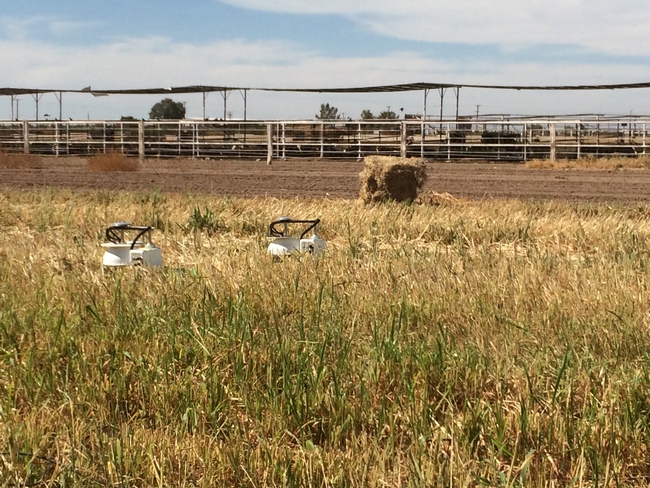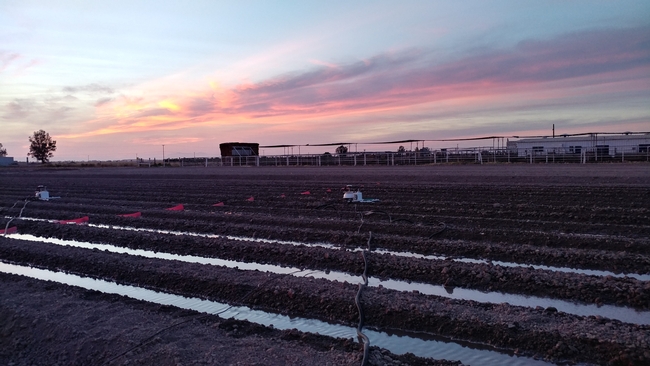Study at Desert Research and Extension Center highlights agriculture's sustainability role
Under the blistering sun of Southern California's Imperial Valley, it's not surprising that subsurface drip irrigation is more effective and efficient than furrow (or flood) irrigation, a practice in which up to 50% of water is lost to evaporation.
But a recent study also concludes that drip irrigation can dramatically reduce greenhouse gas emissions from soil – which contribute to climate change and unhealthy air quality in the region – without sacrificing yields of forage crops alfalfa and sudangrass.
“It was really exciting to see,” said lead author Holly Andrews, a National Science Foundation postdoctoral fellow at the University of Arizona. “The crop yield was at least maintained and in some cases increased, but the water use and gaseous emissions were especially decreased under drip irrigation.”
Desert REC crucial to collecting data
Andrews and her colleagues gathered data from field studies at University of California Agriculture and Natural Resources' Desert Research and Extension Center, a crucial hub of desert agriculture research for more than 100 years. Studies in that context are increasingly important, as much of California and the Southwest becomes hotter and drier.
“We already have this history of looking at drip irrigation at this site, so our study was trying to build on that,” said Andrews, who lauded Desert REC's facilities and staff.
In their study published in Agriculture, Ecosystems & Environment, researchers found that – in comparison to furrow irrigation – drip irrigation in alfalfa slashed per-yield soil carbon dioxide emissions by 59%, nitrous oxide by 38% and nitric oxide by 20%.
Nitrous oxide is a greenhouse gas with nearly 300 times more warming potential as carbon dioxide, and nitric oxide is a precursor to ozone and major contributor to air pollution.
While drip irrigation only decreased water demand 1% in alfalfa, the practice led to a substantial 49% decrease in irrigation for sudangrass. For more fertilizer-intensive sudangrass, drip irrigation also reduced soil emissions of nitrous oxide by 59% and nitric oxide by 49% – the result of drip irrigation making those fertilizers more efficient.
Water management can help mitigate climate change
Studying alfalfa and sudangrass – forage crops with very different fertilizer requirements – was a strategic choice by the researchers. They are number one and number three on the list of most widely grown crops by acreage in the Imperial Valley (Bermudagrass, another forage crop, is number two).
With so much land dedicated to producing these crops, the adoption of drip irrigation at scale could deliver significant benefits to residents' health and quality of life.
“The thought that saving water can increase yields while lowering the emission of trace gases that affect regional air quality and Earth's climate is quite encouraging,” said Pete Homyak, an assistant professor of environmental sciences at UC Riverside who contributed to the study. “This is especially true for the Imperial Valley, an arid region where water is a limited resource and where residents are exposed to bad air quality.”
Homyak, who is affiliated with UC ANR through UC Riverside's Agricultural Experiment Station, said that this study illustrates how changes in water management can substantially mitigate agricultural impacts on the environment.
The study findings should encourage growers to replace furrow irrigation systems with drip irrigation infrastructure – especially in combination with financial incentives from the state, such as cap-and-trade and carbon credit programs, that can help defray high installation costs.
“It really is worthwhile if you're thinking sustainability and environmental activism in how agriculture can actually support climate change mitigation,” Andrews explained. “These practices might be a way that we can start to change that picture a little bit – and make agriculture more sustainable by tailoring irrigation management to local climate conditions.”
In addition to Andrews and Homyak, the other study authors are Patty Oikawa, California State University, East Bay; Jun Wang, University of Iowa; and Darrel Jenerette, UC Riverside.

